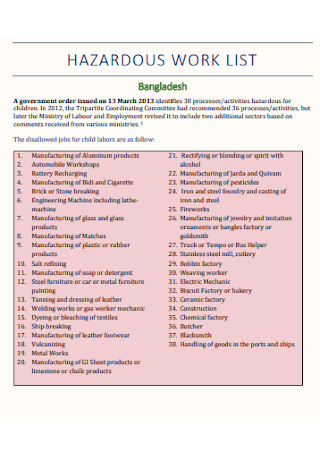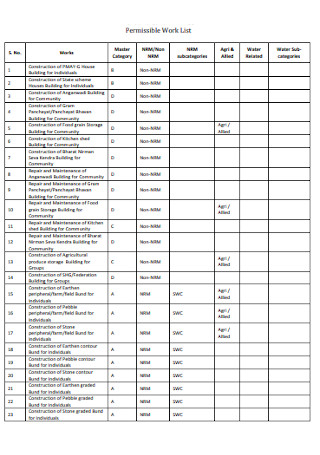A company can be successful not only with its proven and tested technical competencies but also because of what is behind their actions and operations. Knowing that your business…
continue reading
14+ Sample Work Lists
-

Weekly Work List
download now -

Work List for Youth Employment
download now -

Hazardous Work List Template
download now -

Permissible Work List
download now -

Work List of Minor Repairs
download now -

Work List of Academic Template
download now -

Simple Work List Template
download now -

Work-Content Skills List
download now -

Hospitals Work List Template
download now -

Central Work List Template
download now -

General Purpose Worklist
download now -

Work Task List Template
download now -

Work Listfor Maintenance of Roads
download now -

Basic Work List Template
download now -

Work List Format
download now
What Are Work Lists?
A work list refers to a document that enlists the different work items to be accomplished or performed. It is basically like your personal to-do list, except a work list is meant for professional use. In short, a work list is your official agenda. In terms of how it works, you simply write down the many activities expected to complete and work on them one by one afterward.
Did you know that 41% of to-do lists aren’t actually done? That is according to HuffPost.
What Makes a Work List Important?
Whether you are a proprietor, employee, or even a student, you would eventually come across a work list in your life. Work lists are not only easy to make, but they also serve a great purpose. And in this section, you will learn about some of the major highlights that prove just how essential work lists are.
Ditch Memorizing and Forgetting
Are you the type of person who easily forgets what to do or finds it challenging to memorize a lot of work tasks to complete? Then a work list marks your official reference list to be guided in every work activity you have. You can place as many items inside the list as you want in an organized manner. So the next time you need to review what needs to be done for today’s work or any working day, refer to your work list.
Detailed Outline of Tasks
It helps when a work list isn’t only listing a general set of tasks. Be specific with the tasks for clarification upon following your list later on. You can be as detailed as possible such as including a work calendar, job planner, visual aid, and other data besides the itemized list of tasks. In other words, you can benefit from the work list for other functions rather than just viewing the list of work tasks.
Customizable on What Works for You
Work lists need not be the same for every user. You can personalize it however you want. If you think you are more organized using bullet points, using sketches, or any other listing style, then do so. A work list can be edited according to your preference. So rather than just allowing someone else to make a work list for you, it would be much better to create your own so it aligns with your preferred format, layout, content, and other data.
Works for Different Types of Work
A work list sounds broad, right? Work can refer to anything whether it is student work, research work, exercise work, business work, or even personal work. So it helps to specify what sort of work you are focusing on in the work list to prevent confusion. Whether you belong on the top ladder such as the administrative position or at the lower bottom of an organization, work lists are as helpful for anyone to ensure that work tasks are completed efficiently.
The Components of a Standard Work List
Indeed, the work list’s definition and importance are already clear. So how do work lists work? Although work lists from every user may differ in appearance, purpose, and content, standard work lists usually contain the following components:
Different Styles to Present a Work List
Now that you already know what makes up an average work list, it is time to get introduced to the various styles you can present a work list. You might be surprised that work lists need not be presented in a simple task list form. And here are some of the work list styles you can use:
Numbered To-Do List
Probably the most basic approach to presenting a work list is to do a numbered to-do list or checklist. In this style, you simply create an itemized list of work tasks but are numbered from one until the very last number of your tasks. And this type of style is mostly used for work tasks that are to be done in chronological order, meaning the first item should be managed first while the rest follows.
Task Checklist
A work list in task checklist style is when your list of commands have a checkbox beside each item. This one is recommended if you need proof or an easy monitoring system that you really covered your work list without forgetting anything. Maybe you end up doing the same action twice or that an action was ignored if no progress tracker was implemented in your list.
Troubleshooting Work List
Another example is the troubleshooting work list. In this case, you don’t simply outline the work processes to accomplish. Instead, you include solutions whenever certain procedures go wrong. An example is when you need to create business documents on your computer. If that computer stops working, then use the troubleshooting work list section since it is expected to contain the steps on how to deal with something wrong.
Visual Work List
From the name itself, you can tell that a visual work list involves graphics. And it is true because you won’t only be expecting words and numbers in your work list. You can use drawings, figures, and even codes that other people won’t understand, which would help users with private work tasks. Whether you need to insert an icon, visual schedule, or even a table, go for what works on your work list visually.
Work Schedule
When a work list is more concerned about the timesheet or every specific date of a work task, you are already using the work schedule style for your work list. So be sure to include the relevant time and date details in the work list so you won’t miss a deadline or get late with any task.
How to Make a Solid Work List
According to HuffPost, 41% of to-do lists aren’t done. And it only makes sense to put some effort into making your work list as effective as possible to ensure that you will actually do the itemized tasks there. It will be easy to achieve anyway once you follow these five steps:
Step 1: Assess Your Work List’s Purpose
Create your own statement of purpose regarding what your work list is for. Do you plan to make one for your business work, research work, or any other type of work? Once you are sure of its function, begin making a draft of the possible tasks or commands expected to be listed in your work list. It is alright if the tasks aren’t arranged or properly written since the draft is still your guide. And this first step is important because it is the very foundation of your work list.
Step 2: Optimize a Work List Sample
Every work list example you need is enlisted in this article. Just choose a sample work list template and you may edit its format and data afterward. The best part of using work list samples is how you need not make a list from scratch. But at the same time, you can also change the layouts and details from the samples. A win-win situation. So optimize your chosen template since it is editable, downloadable, and printable.
Step 3: Lay Out the Components of a Work List
Your work list can certainly benefit from the basic components of a work list, as previously tackled. From the title, basic details, down to the notes segment, these components make your work list feel complete. If your work list lacks important details, then you can hardly depend on that document for a long time. If you want to create your own section such as a mission statement, work budget, or anything, you can also do that.
Step 4: Follow Your Preferred Work List Style
You learned earlier that there are many styles on how your work list can be presented. Whether you opt for a numbered to-do list, task checklist, or any other option, make sure you are comfortable and alright with that style for your own good. If you haven’t decided yet, try out each work list style and figure out which is easier or better for you. Also, you can even mix up different styles such as a hybrid work list designed in both a numbered to-do list and a work schedule.
Step 5: Take It Easy
There is no pressure in creating the work list, especially when there is no strict format involved into making one. With that said, focus on making your work list easy to read or follow. Another tip is to write detailed but specific instructions. It will surely get rid of any possible confusion. The best part in making the work list is you can create your feedback and recommendations after following the list. If it helped you a lot, continue doing it. If not, then adjustments may be needed for the work list or your motivation to complete the actions.
FAQs
What are the types of work?
The main types of work or working patterns are the standard work (traditional eight-hour work schedule), flexible work (flexible working hours), shifting work (shift schedule), agency work, freelance work, and working for yourself.
What is a job list?
A job list or job listing refers to the list of open jobs aspiring candidates can apply for. And these lists usually detail the educational requirements, work experience requirements, job description, and steps on how to apply.
At the end of the day, there is no exact answer as to what the appropriate format of a work list should be. It is up to what works for every user. If you need your work list to be short and direct, go for it. If you like it detailed and comprehensive, you may do so. Just make sure that however you want the work list to turn out, you must follow its commands rigidly and responsibly. Otherwise, the whole point of creating an excellent work list would be for naught if you won’t commit to it. Get started and download a sample work list now!

